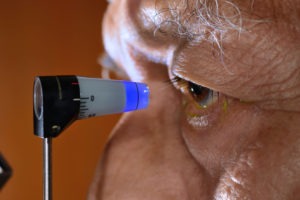January is Glaucoma Awareness Month, and at Vision First, we want to keep our patients (and non-patients!) informed of this dangerously quiet disease.
It is estimated that 60 million people worldwide have been diagnosed with or are living with glaucoma, with that number expected to rise in 2017. Because the signs of glaucoma are hard to detect, around half of those who suffer from the disease are unaware they even have it.
Though there is no known cure for glaucoma, the ophthalmologists and optometrists at Vision First Eye Center offers numerous types of comprehensive eye exams to test for glaucoma, as well as multiple treatment options.
What is Glaucoma?
Glaucoma is an eye disease that damages the eye’s optic nerve, the connection between the eye and the brain. When the optic nerve gets damaged, the delivery route for the images becomes blocked, preventing the brain from receiving image signals. Long-term damage to the optic nerve results in vision loss.
There are four common types of glaucoma:
- Narrow Angle-Closure glaucoma
- Primary Open-Angle glaucoma
- Normal-Tension glaucoma
- Secondary glaucoma
What Causes Glaucoma?
Though the exact cause of glaucoma is unknown, glaucoma is normally associated with an increase of intraocular pressure to excess fluid in the eye.
What are the Risks of Glaucoma?
You are more likely to develop glaucoma if you:
- Are over the age of 60
- Have a family medical history of glaucoma
- Are African American or Hispanic
- Changes in the lens or uveal tract
- Have had serious eye trauma
- Have certain medical conditions such as diabetes, heart disease, high blood pressure, or have high internal intraocular pressure
What Signs Should I Look For?
Unfortunately, the most common forms of glaucoma have few symptoms, sometimes none at all, especially in the early stages of glaucoma. Most who suffer from glaucoma do not experience any noticeable changes in their sight for many years. Damage from glaucoma normally starts with the peripheral vision and gradually progresses inward, proving that a patient can have advanced glaucoma yet still maintain 20/20 central vision. Symptoms vary depending on the type of glaucoma you may have.
You may have glaucoma if you experience:
- Dilated pupils
- Reduced peripheral vision
- Sudden eye pain
- Headaches
- Tunnel vision
- A serious eye injury, eye infection, or enlargement of the lens due to presence of a cataract
Are There Treatments for Glaucoma?
There is no cure for glaucoma – but Vision First can help treat it. We offer various treatment methods depending on your unique case. Glaucoma treatments include medicine, conventional surgery, laser trabeculoplasty, or a combination of these.
Schedule your Regular Eye Exam with Vision First
The only true way to catch glaucoma before it worsens is to schedule a comprehensive eye exam with us every 1-2 years, especially if you have a family history of glaucoma.
There are five tests used to determine if you have glaucoma:
- Dilated eye exam: using eye drops, we dilate your eyes to allow us to examine your retina and optic nerve for signs of damage
- Visual acuity test: this standard test measures how well you see at various distances
- Visual field test: a field test measures the effectiveness of your peripheral vision, which can pinpoint early symptoms of glaucoma
- Tonometry: during this test, your doctor measures the pressure inside your eye
- Pachymetry: your doctor will apply a numbing drop to your eye, then measure the thickness of your cornea using an ultrasonic wave instrument
- Optical Coherence Tomography (OCT): this technology scans the nerve layers in the eye, looking for/measuring damage.
Awareness is the first step in preventing glaucoma-related vision loss – and the second step is an annual eye exam. In the spirit of Glaucoma Awareness Month, we encourage you to share this article and schedule your comprehensive eye exam. Don’t wait until it’s too late!
For more information on what you can do to stop vision loss, call a Vision First Eye Center location in Birmingham, Alabaster, Trussville or Pell City.








